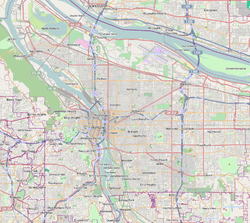Johan Poulsen House
Johan Poulsen House | |
Portland Historic Landmark[2] | |
 The Poulsen House in 2010 | |
| Location | 3040 SE McLoughlin Boulevard Portland, Oregon |
|---|---|
| Coordinates | 45°30′03″N 122°39′36″W / 45.500957°N 122.660039°W |
| Area | 0.3 acres (0.12 ha) |
| Built | 1890 |
| Architectural style | American Queen Anne Style |
| NRHP reference No. | 77001113[1] |
| Added to NRHP | March 14, 1977 |
The Johan Poulsen House is a three-story American Queen Anne Style mansion in Portland, Oregon's Brooklyn neighborhood. It was built in 1891 by an unknown architect.
House details
[edit]Poulsen bought the property in July 1890 for $3,000, and the house was completed in August 1891.[3] Poulsen sold the house immediately to S. B. Willey, probably either due to financial issues caused by the lead-up to the Panic of 1893 or because his wife, Dora, did not like it.[3] He sold it on a mortgage to Willey and sold it outright to Arthur Zwicker for $7,500 on July 14, 1894.[3] Alternately, the home was sold to William J. Clemens, an Oregon senator, in 1902.[4]
The house was built in 1891. The turret reaches approximately 50 feet.[3] It includes a bedroom on the first floor for a servant. It contains two lead glass Oriel windows, a Palladian window, curved glass in the turret, and beveled lead glass windows.[4][5] The home also contains a veranda, added around 1915.[5] It is considered a "Pacific Northwest interpretation of the Queen Anne Style", since it does not contain stone or brick.[4]
The interior features a large carved oak fireplace and mantel, carved stairway balustrades, and oak flooring with a mahogany border.[4] Containing nine bedrooms and 12-foot ceilings, the maid's bedroom is on the first floor, with four bedrooms on each of the second and third floors.[3][4] The third floor may have originally been a large ballroom.[4]
The home was bought by "The Doughnut King", A. A. Hoover, in 1919, and became known as the "King's Castle" or "The King's Palace".[3][4] The property was then sold to Henrietta B. Huthman in 1923, whose family owned it until 1946.[4] The Huthman family added the two-car garage and large retaining wall in 1926.[4] The two-car garage was connected to the house via tunnel.[4] The home was converted to a boarding house sometime between 1946 and 1976.[4] James F. Nevin purchased the house in approximately 1976 and began restoring it.[4]
The house was surveyed by the Portland Historical Landmarks Commission on October 3, 1973, and was added to the National Register of Historic Places on March 14, 1977.[4]
In 2017, the Poulsen House was purchased as a home for Prospect, a Portland communications, design, government relations, & digital media agency. Prospect sold the house in 2019
Johan Poulsen
[edit]
Poulsen was born in 1849 as Johannes Poulsen in north Slesvig, Germany.[3] The area of his birth is now Denmark.[3] He came to Iowa in 1870, married his wife Dora in 1873, and came to Portland in 1875.[3]
Before 1890 he also owned part of the North Pacific Lumber Company and Willamette Steam Sawmill Company.[3] He sold his ownership of these companies to start the Inman-Poulsen Lumber Company (which would eventually be absorbed into Georgia-Pacific) with Robert D. Inman.[3] Their company had a sawmill on the east side of the Willamette River at Clinton Street.[3] The sawmill dock could accommodate two oceangoing ships at a time.[3] Inman had an almost identical house at 6th and Woodward Street, which was demolished in 1958 to make room for a parking lot.[6]
By 1903, the Inman-Poulsen company was the largest lumber company in Oregon with 350 employees, later peaking at 700 employees.[3] The large lumber mill had a conveyor belt piling sawdust, which went to a Portland General Electric plant located next door.[3]
Poulsen built another large house on Hassalo Street in the Lloyd District, replaced by a Red Lion hotel later.[3]
See also
[edit]References
[edit]- ^ "National Register Information System". National Register of Historic Places. National Park Service. July 9, 2010.
- ^ Portland Historic Landmarks Commission (July 2014), Historic Landmarks -- Portland, Oregon (XLS), retrieved September 4, 2014.
- ^ a b c d e f g h i j k l m n o p Snyder, Eugene E. (1991). Portland Potpourri. Portland, Oregon: Binford & Mort. pp. 73–79. ISBN 0-8323-0493-X.
- ^ a b c d e f g h i j k l m James F. Nevin (October 15, 1976). "National Register of Historic Places Inventory Nomination Form: Johan Poulsen House" (PDF). National Park Service. Retrieved 2014-11-18. Photos
- ^ a b Hawkins, William John III; Willingham, William F. Classic houses of Portland, Oregon: 1850-1950. pp. 165–166. ISBN 978-0-88192-433-6. OCLC 40948520.
- ^ "Cafe Unknown". www.cafeunknown.com. Retrieved 2018-02-26.


